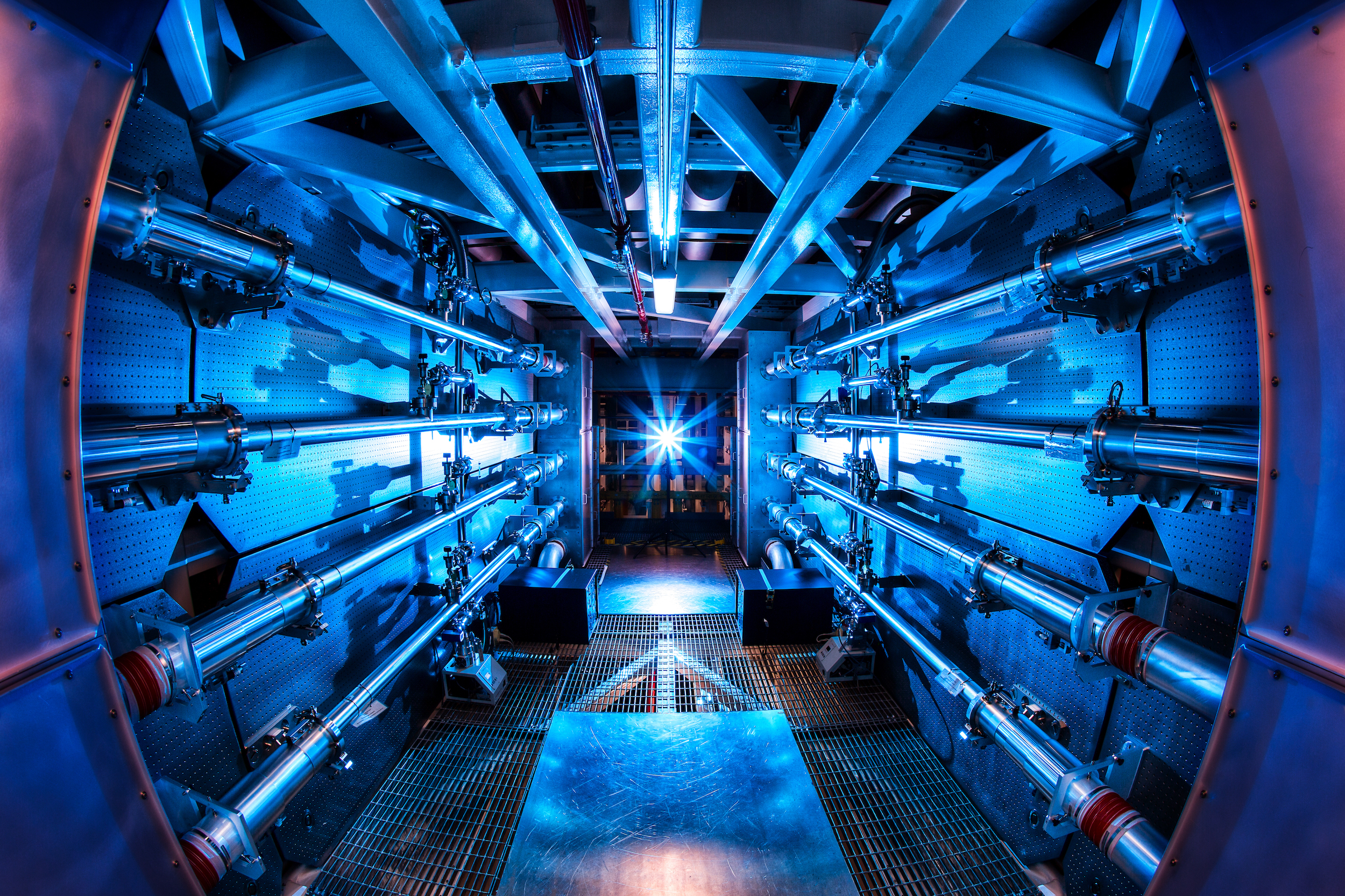Scientists at the National Ignition Facility (NIF) in Livermore, Calif. announced a significant breakthrough in their nuclear fusion experiments Tuesday. Big Plasma Fusion Knowers—a small community of scientific elites that includes yours truly—did not need to watch the announcement in order to know what is going on. Because the announcement was made by scientists experimenting with inertial confinement fusion, any breakthrough worthy of a press event had to be the achievement of breakeven, the elusive and all-important point where a fusion reaction generates more thermal energy than it consumes in input energy. I did not sit up in bed or even crack one eyelid when one of my many overworked physics interns barged into my sleeping chamber to alert me that an inertial confinement fusion lab was prepared to announce a so-called breakthrough. With the science fairly well-established and our planet on the brink of climate catastrophe, there is only one real breakthrough, and this is that.
Here's what's going on: By firing their 192 lasers at a solid-gold thimble-sized cylinder containing a diamond-encased BB-sized blob of fuel-soaked foam, researchers at NIF have for the first time in human history generated surplus energy in a laboratory fusion experiment. Because it was tinkering and not scaling-up of this experiment that triggered the breakthrough—it's the same 192 lasers aimed at the same tiny sphere of fusion fuel—the energy amounts generated in the experiment are super duper tiny, roughly enough in surplus energy to power a 60-watt lightbulb for a week or so. Don't get distracted just yet or discouraged by the tiny output: Though a True Physics Expert such as myself might smile mirthlessly and dismiss an overeager intern with the utmost contempt at the suggestion that this news comes as a surprise, it is still a hugely important development in humankind's pursuit of a clean, abundant energy solution.
I am able to blog convincingly about this topic despite having missed the announcement due to watching Mary Poppins instead because the various and loosely competing fusion reactors experimenting with energy yield around the globe have for the most part progressed to fairly linear development arcs. Where decades ago fusion researchers were independently experimenting with techniques and materials and capacities for triggering nuclear fusion in a laboratory reactor, and where even just a couple years ago they were trying out different reactor shapes and isotope cocktails and were doing plasma burns for pure research, the methods have now been well-honed and the focus has shifted at several projects to a direct chase of breakeven. In magnetic confinement fusion, various projects are underway to scale existing reactor types to the point where breakeven is described as basically inevitable—when France's International Thermonuclear Experimental Reactor (ITER) or the United Kingdom's Spherical Tokamak for Energy Production (STEP) or Commonwealth Fusion Systems' SPARC reactor next announce a breakthrough, it will mean that they have finished building their prototype reactor, and it either is or is not achieving its one goal, which is breakeven. The intern who expects me to show the merest sign of life upon being told of a breakthrough announcement in magnetic confinement fusion will instead feel the absolute most withering chill of disgusted silence.
Magnetic confinement fusion—the method pursued by ITER, STEP, and SPARC—uses big honkin' magnets, supercooled to deep-space temperatures, to suspend and activate relatively large blobs of a particular naturally occurring cocktail of hydrogen isotopes, which burn at mind-boggling temperatures in self-sustaining fusion reactions. Researchers working at the Lawrence Livermore National Laboratory's NIF, the source of Tuesday's big breakthrough announcement, are pursuing what is called inertial confinement fusion. Inertial confinement fusion, in this model, takes a very tiny amount of the same basic hydrogen cocktail and socks it inside something called a hohlraum, which looks like a gold-plated shell-casing of a small-caliber bullet, and which has an interior chamber lined with diamond. The hohlraum is held by a mechanical arm in the center of a very dramatic-looking science chamber, where it is bombarded by 192 extremely powerful lasers. The exterior of the hohlraum basically explodes, blasting out x-rays and shockwaves that powerfully compress the diamond, which in turn powerfully compresses the fuel, which heats to the point that the nucleii of the hydrogen atoms fuse into heavier elements, a process that throws off a lot of bitchin' energy. The yield of that bitchin' fusion reaction, however brief, is knowable, and can be measured against the electricity used to power the lasers. Back in August 2021, the NIF produced a then-record 1.3 megajoules of energy yield using about 1.92 megajoules of laser energy, which was a very encouraging 25-fold increase over the previous record yield, set in 2018.
A shot in December 2022 that yielded, say, 1.89 megajoules of energy against the same 1.92 megajoules of input would be a cool advancement, but would not be worthy of a whole big press engagement. But an experiment which yields just about three megajoules of energy at the same input level, as the NIF announced Tuesday, is genuinely a scientific breakthrough of everyone-shut-the-fuck-up-and-listen proportions. That surplus megajoule or so of energy yield points definitively to a future where clean-burning fusion energy, using infinitely abundant naturally occurring fuel, could replace humankind's planet-consuming reliance on fossil fuels.
Now. Scaling inertial confinement fusion for commercial energy production will be fantastically complicated, and possibly impossible. For one thing, the current setup uses a whole huge complex facility and 192 lasers to produce less energy than is needed to run a countertop microwave for 20 minutes. Think of how many fuckin' lasers it will take to nuke a hohlraum holding enough fuel to power your damn Playstation long enough for one wasted night of gaming action. For another, commercialized fusion energy will require much higher relative energy yields: Consider that NIF's big breakthrough laser show produced about half as much surplus energy (approximately one megajoule) as will be needed to produce the NIF's next equivalent laser show (approximately two megajoules). And that's not the worst of it: As explained by Vox, energy is being used in the experiment beyond the 1.92 megajoules of laser heat bombarding the hohlraum. It currently takes something like 300 megajoules of electricity for the NIF facility to blast 192 high-powered lasers long enough to hit the hohlraum with 1.92 megajoules of energy. So, ah, more tinkering will be required, both at maximizing yield and at minimizing the energy needs of the tools used to produce fusion-triggering input energies, before this thing could ever be commercialized. At a minimum, these nerds need some more efficient lasers.
And there is still the matter of harnessing the surplus energy and converting it into distributable electricity, via a traditional turbine system, something that has not been addressed at all in the design of the NIF fusion reactor. A lot will need to happen before there is a local inertial confinement fusion reactor doing cool laser shit and powering your nightlight. So much, in fact, that it may never come to pass, and not only because the science is in an active race with centuries of preexisting technology, virtually all of which is accelerating the death of our planet. But it's important to identify precisely what has been proven, once and for all, via this tiny-scale fusion reaction. There is now actual recorded proof of a human-controlled plasma fusion experiment yielding a net energy gain, something scientists have been pursuing for whole generations. That it has been achieved by any means at all means once and for all that breakeven is more than theoretically possible. Energy breakeven, at the level of energy in and energy out, is scientifically settled. That's cool, and possibly even encouraging.
On the other hand, let us take a sobering moment to be realistic about our fusion future. The race to commercialize fusion energy has pulled ahead of the science. The extremely well-meaning engineers and physicists building SPARC, for example, as we speak are manufacturing the parts for a commercial reactor and bolting them together, despite not having proven in their experimental reactors that their model achieves breakeven, to say nothing of the hefty surplus yields needed to be truly commercially viable. This is all taking place inside the same psychotic top-heavy late-stage capitalist economy that recently spit out Tesla, Netflix, DoorDash, WeWork, Carvana, Bird, Uber, Twitter, Airbnb, and Theranos, to say nothing of the whole insane Ponzi-structured cryptoeconomy. The ultra-rich and insanely over-leveraged investor class is in ever more deranged pursuit of opportunities to multiply surplus wealth; it is perhaps no coincidence that fusion commercialization is, to a really alarming degree, the undertaking du jour of frantic venture capitalists.
Enthusiasm about an impending fusion-powered future should be tempered with a certain amount of skepticism about who is building what, and for what purposes. The scientists doing the research are extremely earnest and cool and brilliant, but the commercial projects are being funded in too large a part by the same people who are fucking everything else for anyone to feel too confident that the commercialization dollars are being spent well, and with the proper expectations. Andrew Holland, CEO of the Fusion Industry Association, told a White House audience back in March that the people paying for all these projects "want to figure out a way to return their money," and are therefore operating on "a limited time frame." The pressure to turn promising experimental developments in fusion science into commercialized energy is coming not just from a warming planet, but from a ravening class of profit-minded investors.
Which means even if this thing works, and humankind finally achieves clean energy from endlessly abundant natural fuel sources, there's a very strong likelihood that the various extremely serious governments of Earth will just leave it in the hands of, like, Elon Musk, who will only use it to power a new globe-spanning fleet of single-passenger go-karts that can only be piloted remotely by an app and often burst into flames.






